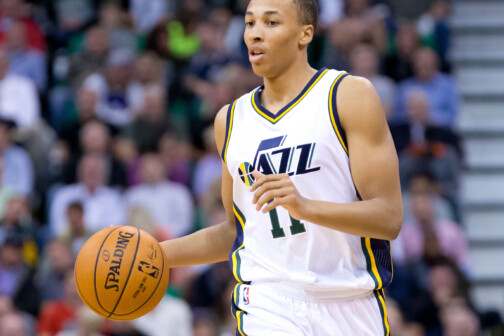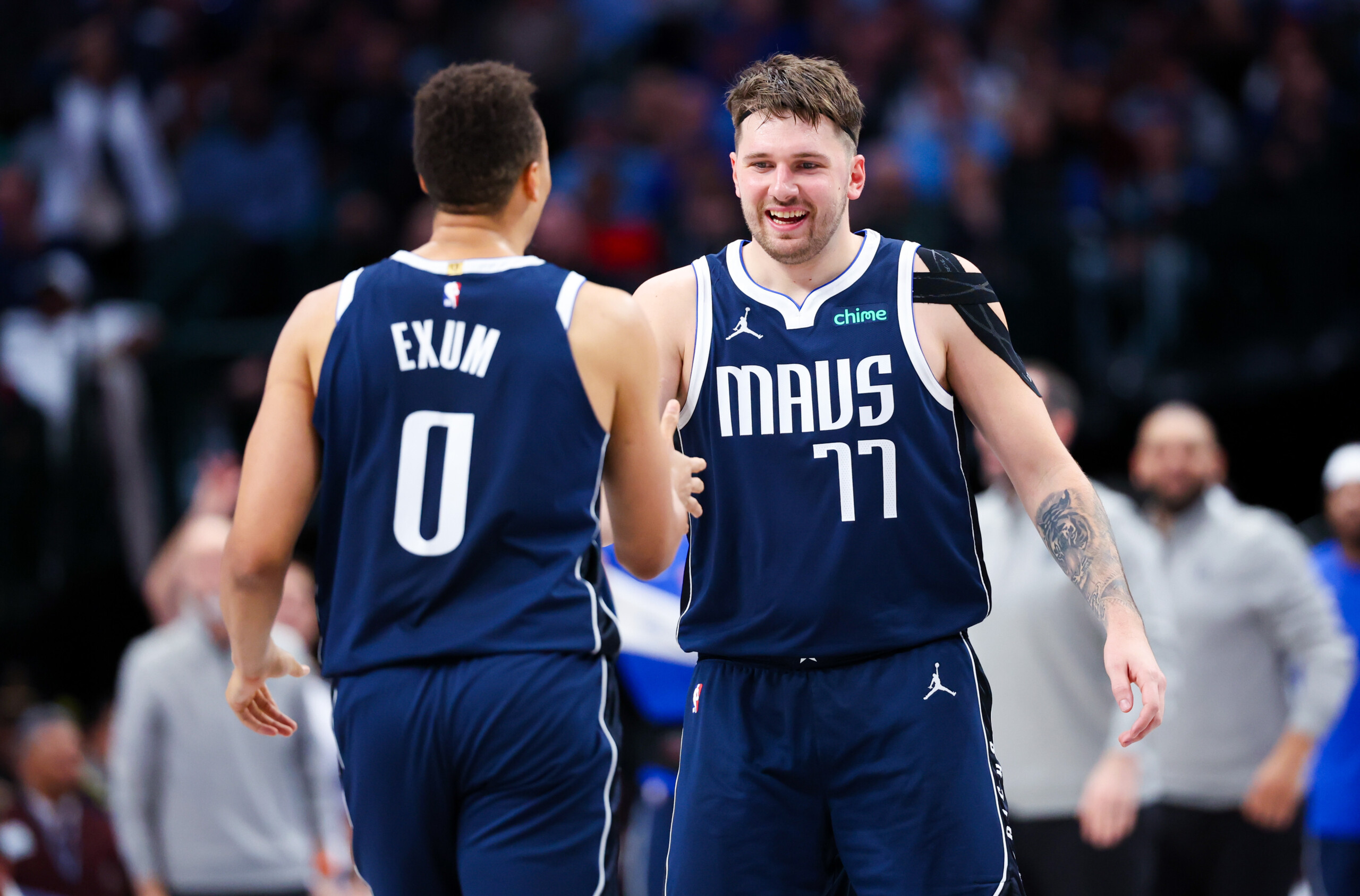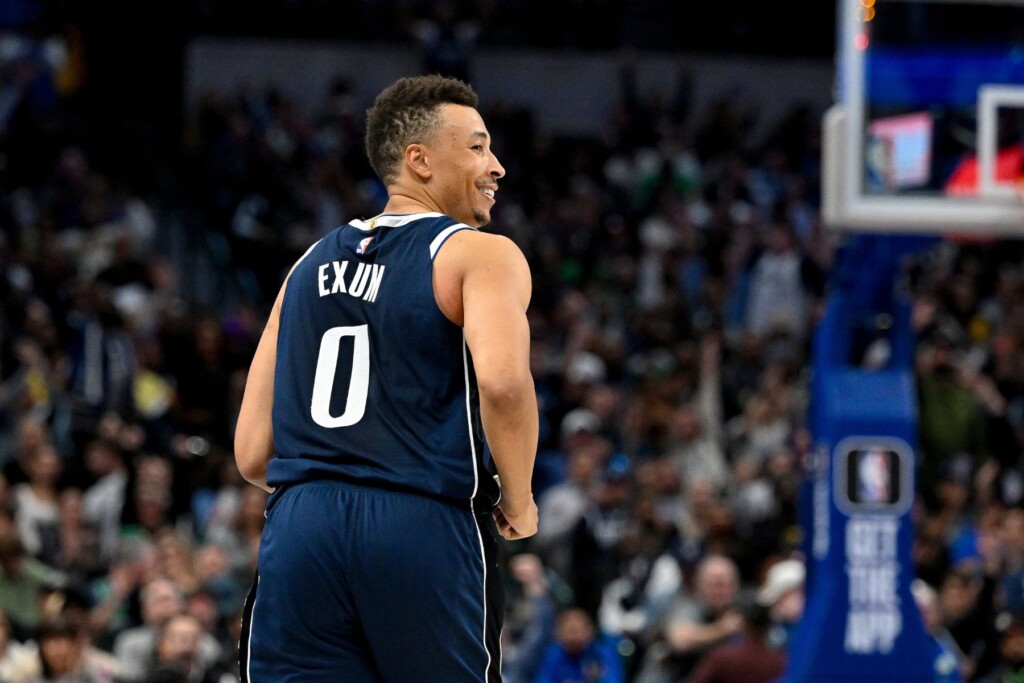It was an inconspicuous return.
On October 25, the Mavericks traveled to San Antonio for their season opener. There to receive them was a boisterous crowd set to witness the debut of Victor Wembanyama, the best NBA prospect in a generation. On the other side, future Hall of Famers Luka Doncic and Kyrie Irving. It was the most-watched Mavericks-Spurs game in the history of their storied rivalry, peaking at 3.9 million viewers. And there, somewhere in the background, was Dante Exum, back on an NBA roster for the first time in two years after stints with FC Barcelona in Spain and Partizan Belgrade in Serbia. He would score three points in a seven-point Dallas win.
For the uninitiated: Exum was the fifth pick in the 2014 NBA draft, a kid who wouldn’t turn 18 until a month after being selected by Utah yet was expected to become the face of the franchise. He was tall, fast, and explosive. But a string of injuries throughout five seasons tethered his development, prompting Exum to chart a course through the European circuit. Most believed he was a bust, that his NBA career was curtains.
But in the offseason the Mavericks signed Exum to a two-year minimum contract.
Nineteen games and a slew of Mavericks injuries later, Exum was thrust into the starting lineup. All he’s done since is shine, averaging 15.6 points, 4.4 rebounds, and 4.2 assists over 10 starts to solidify himself as part of Jason Kidd’s opening lineup.
“One of the things Coach Kidd wants to do this year is push the ball, that’s something I can do with my speed and pace that a lot of the guys are learning,” Exum says. “I can push the ball into the paint, open looks, make the right plays. That’s my biggest strength.”
Finally, he is starting to look like the player so many expected he’d become a decade ago. His jumper has improved. His body has stayed sturdy. And most of all, the man has matured.
“It’s been quite a journey,” Exum says. “I wouldn’t change anything.
“That hunger of missing a lot of games has driven me to make sure I stay on the court.”
Before he had made his first NBA bucket, Exum told reporters on draft day in 2014 he wanted to be thrown into the deep end. He relished the opportunity to grow. The Australian was billed as an athletic kid with acceleration and length (an 81-inch wingspan) who could torch defenders off the dribble. He had a quick first step and crafty court vision. Sure, he needed to hit the weight room, and his shot needed work, but the potential was there.
Some labeled him the next Tracy McGrady. Others saw shades of Michael Carter-Williams. Or maybe he was the next Penny Hardaway. Going into the draft, Exum had already been featured in commercials for Foot Locker and had signed with Adidas. But if he was feeling any pressure to produce, he didn’t show it.
In front of the microphones and tape recorders, he described himself as “adaptive” and “unique.” He tried to make himself into an amalgamation of so many players he admired: explosive like Russell Westbrook, a finisher like Manu Ginobli, fearless driving into the paint like Tony Parker getting in the paint a. The rangy, young guard with the baby face was nonplussed as the media poked and prodded him with questions.
Like most teenagers, Exum struggled to adjust to the rigors of the NBA. In his first season in Utah, Exum played in all 82 regular-season games, averaging 4.8 points while shooting 34.9 percent from the field. But he showed more on the defensive end, and he was still so young, with so much promise. The future was bright.

Then came the lost half-decade. Over the next five years, Exum’s growth was stunted by a series of crippling injuries. First came an ACL tear in August 2015, a season-ending injury that he suffered while playing in an exhibition game for Australia. In 2017, he needed surgery on his shoulder; marooned in Utah without any family nearby, he slept on his teammate (and fellow Aussie national team member) Joe Ingles’ couch in the aftermath of the surgery so he wouldn’t be alone. In 2018, it was the ankles. Upon being traded to Cleveland in 2019, he tore his patellar tendon. After that came the calf problems. After playing in 148 games in his first two NBA seasons, Exum appeared in only 97 over the next five. The one-time prodigy was now damaged goods. NBA interest began drying up.
“For some that could have been a breaking point where they might choose another career,” says Ingles. “He took himself to Europe, and I think you can see the benefits of it now.”
European basketball comes with the reputation that it is physical and isolating: the schedule is grueling, and coaches don’t care if you were the fifth pick in an NBA draft. It’s not for everyone. If you’re not performing, you don’t leave the bench. It’s a shooters’ league, too. And it was exactly the environment Exum was looking for: log meaningful minutes, put his body through physical tests, and get the ball in his hands. He credits his one-year stint with Partizan, his second European club, for what’s translating on the court for him in Dallas.
Ask him what changed, and he’ll tell you growth was more about the intangible things such as awareness, confidence, and leaning into leadership. He worked on his confidence by refining his shot. Not that he didn’t have it before. Perhaps that comes with maturity. But he got used to the notion he was going to take more shots, that his teammates trusted his shot, and his decision-making about when to take certain shots.
“I think that’s what helped me get to that point where I’m at now where I’m comfortable shooting it,” he says.
To that end, in 63 Euroleague games Exum shot 56.8 percent from the field, 41.9 percent from deep, and 85.9 percent from the line.
Brian Goorjian, coach of the Australian national team, who first sighted Exum during his u-18 days, says that players who go down an onerous path are the ones who come closest to becoming the best that they can be.
“He’s resilient,” Goorjian says. “He believes in himself. Through these injuries and setbacks that’s the character of the man to me.”
Goorjian has witnessed the evolution of Exum: from the early days where he was a wild card on the sideline dealing with his banged-up body and constantly rehabbing, to fighting for a spot on the Australian team, to becoming an integral member of the historic Olympic bronze-medal winning team in Japan. Goorjian sees Exum as a future Australian captain.
Goorjian says Exum came to this year’s FIBA World Cup training camp in elite shape because of his European tenure and was among the top three performers as the Australians finished 10th. Amid all of the traveling to Australia and Asia, the training camps, and European competition, Exum grieved the death of his father, Cecil, who was instrumental in his development from a young age.
“When a kid says, ‘I lost my best friend,’ that’s what that relationship was,” Goorjian says. “It was a bond. They shared the love of the same passion. [Cecil] loved his son. It’s one of those stories with all of those pieces. Dante has so many aspects of his character that his father possessed.”
If Europe put Exum back on the path toward the NBA, then his performance against the Lakers on December 12 confirmed he won’t be leaving again any time soon. That night, Exum finished with 26 points, three assists, and four rebounds in 35 minutes as the Mavericks toppled Los Angeles without Irving. Even more important was how he scored those points: by nailing seven of his nine three-point attempts. The weak point of Exum’s game in his last go-around became the tool he used to torch LeBron James and Anthony Davis.
To his head coach, that’s only the start of what Exum has added to Dallas. “He’s playing at a high level right now at both ends,” Kidd said that night. “And again, we’ve talked about his IQ, and he knows how to play the right way with Luka or [Kyrie Irving] or whoever he’s out there with. Those guys trust him.”

Alex Jensen, who joined the Mavericks this year as an assistant coach, was on the Jazz’s coaching staff when Exum entered the NBA. One of the first things he noticed upon reuniting with Exum is the confidence that comes with age.
“Playing in Europe is not easy,” Jensen says. “A lot of guys can’t do it. He’s evolved from a bright-eyed kid who thought he could do it to even more so, the confidence knowing what he can do. Playing with Luka and Kyrie—some guys can get intimidated playing with big stars and wonder how they fit in. There’s a lot of ways Dante can fit in with them and he knows it. And he’s experienced it.”
The Mavericks saw the various roles Exum could fill, which makes him a valuable piece in today’s NBA. He’s capable at the point. He’s long enough to play on the wing. He defends. He can play without the ball alongside Doncic and Irving, but the coaching staff is confident in his ability to initiate offense and take some pressure off the superstar duo.
The answer to why Exum? Why now? Why the Mavericks? Jensen says not a lot of guys in the NBA have all the tools—the quickness, the length, the Swiss Army knife of capabilities. Exum is one of those players where he can fill multiple spots, and as a result, the Mavericks can run out more creative lineups.
“Since he’s been here, everybody sees him more of what he can do than they thought before they signed him,” Jensen says. “It’s been fun to watch the change. He’s gone through a lot since he was an 18-year-old rookie. I think a good word I would use for him is that he appreciates it. When you come into the NBA, you’re not going to appreciate it as much as you would being out and coming back in.”
Watching Exum move, seeing him throw his body around and drive at the rim at full speed, there’s a tension and nervousness to it. He doesn’t think about the things he can’t control, like how he might land after a dunk or getting clipped in the face by an elbow while defending in the paint. What’s the point? When Exum embarked on his European path, he had no idea where the road would take him. He wasn’t thinking about the NBA then. And now he’s back he’s trying to live in the now, focus on what’s in front of him: starting for the Mavericks, staying healthy, and continuing to be an early front-runner for Most Improved player. Then, next year, Olympic basketball.
“Where I was and where I’ve come from, I just want to stay on the court and play every game,” he says.
Two months into his time in Dallas, he’s achieving much more than that.




